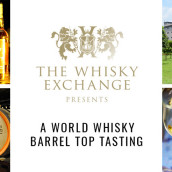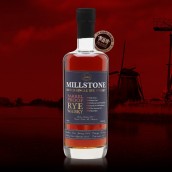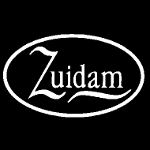Last year, I received half-a-dozen samples of Dutch rye whisky. They varied considerably, in terms of cask type, age and number of distillations, but what they all had in common was the amazing amount of fruit. One sample, in particular, stood out, and we knew we had found something special.
This rye whisky sample had the spice and rich sweetness of the best American rye, but there was thick, jammy fruit and a long finish. It was rye but unlike many of its traditional compatriots you could drink it straight or mixed. Indeed, it was so easy to drink neat, the sample was gone in no time.
So, who produced this magical rye whisky that entranced all in the tasting room that day? Zuidam. And the whisky? Millstone 2004 Barrel Proof Rye 10 Year Old, which has now been bottled exclusively for The Whisky Exchange.
Millstone 2004 Barrel Proof Rye 10 Year OlD, 58.6%
Nose: Rich and sweet to start, reminiscent of cola bottles and vanilla panna cotta. Dry, sweet, spicy and citrus notes dominate, with rye toast, salted caramel, nutmeg and kaffir lime leaves.
Palate: Maple syrup and orange zest. It sweetens as it develops in the glass, with toffee apples, barley sugar, clove and caraway. The buttery sweetness seems to be tempered by dry spice and flavours of raisins macerated in brandy. It is mouth coating, with only a touch of the traditional dryness you find in rye whiskies.
Finish: Soft, with flavours of sliced apple and cinnamon toast.
I met up with Patrick van Zuidam, the man who created it.

Patrick van Zuidam
‘Making spirits and liqueurs is easy. It is like sex; it just takes experience.’ Patrick is one of the most laid-back distillers I have ever met. Having been brought up in the distillery, which was set up in 1975 by his father, Patrick set his sights on becoming one of the only distillers in the Netherlands to create a jenever from ‘grain to glass’. Most distillers in the mid-1990s bought in neutral grain spirit for their base (like many UK gin distillers do now), but Patrick wanted to make sure he was only using the best ingredients.
Having installed the equipment to produce genever, whisky became almost a by-product (‘everything was in place, so why not also make whisky?’) but as with Zuidam jenever and liqueurs, Patrick had no intention of taking the easy road. Everything about the production of Millstone whisky at Zuidam seems to be the opposite of the way the Scotch industry is heading.
For a start, many distillers in Scotland have moved to distiller’s yeast for maximum extraction of alcohol, but Zuidam adds a proportion of Belgium brewer’s yeast, which is less efficient but leaves more of the sugars in the wash, creating a fruiter style. This usually takes five days of fermentation, but recently Patrick has increased this to seven to ramp up the fruitiness. He also uses temperature-controlled fermenters to get the best conditions for brewing, a technique often used in beer making but not often seen in traditional whisky production.
The best example of the extremes Patrick is willing to go to achieve his goal of producing great whisky can be found in the 100% rye. The mash bill is 50% unmalted rye and 50% malted rye. After fermentation, you end up with a thick alcoholic porridge. Putting this into a pot still is, in Patrick’s, words ‘like shooting yourself in the foot’, because the still is very hard to clean – but he does it anyway.
Millstone 100 Rye WhiskY, 50%
Nose: Candy, cinnamon and ripe blueberries. A lot of rich notes in the glass but the balance is delicate and subtle.
Palate: Creamy vanilla at first. Some darker chocolate and sweet spice, nutmeg and cinnamon coming through with jammy fruit building around the side of the palate. Starts softly, then with time on the palate, more vanilla pod and dried coconut notes come through. The fruit is autumnal with cherries and blueberries.
Finish: The fruit and spice linger for ages – berry flavours balanced with rich vanilla sweetness.
What struck me most Patrick is his fondness for traditional methods. He experiments, yes, but uses his understanding of distillation and his ambition to create fruity flavours in his spirit to dictate his decisions. Like a great chef, he makes sure he uses the best ingredients and knows their provenance. He is not looking to make a good ‘Dutch whisky’, a good ‘European whisky’ or even a good ‘world whisky’. He is looking to create great whisky comparable to, if not better than what is coming out of the traditional whisky nations.
This brings me back to the rye whisky he has created for us. It is not just a good whisky; it is more than comparable with the top rye whiskies on the market. Compared to its peers, the balance of traditional spice and rich fruit is fantastic. Unlike many ryes, it is a great sipping dram but still gives all the spice and flavour for a great Manhattan or Sazerac. For me, this is as good as rye gets and I think it achieves the very thing that Patrick wants it to: it’s a great whisky.












 Enjoy responsibly
Enjoy responsibly
Comments
RT @WhiskyExchange: #Zuidam Distillers are making some excellent whisky, including some world-class ryes – http://t.co/OruABKGMFU #blog
Zuidam Distillers – making world-class rye http://t.co/np8LfQgh7A http://t.co/sBy5A5Dyse
RT @WhiskyExchange: #Zuidam Distillers are making some excellent whisky, including some world-class ryes – http://t.co/OruABKGMFU #blog
Zuidam Distillers – making world-class rye: http://t.co/2ARUgmp61r via @whiskyexchange
@whiskyexchange @dsappl I want that Zuidam Rye, but it’s so damn expensive. And it doesn’t make sense to order Dutch whisky from the UK
Zuidam Distillers – making world-class rye: http://t.co/1PfpYCLOB0 via @whiskyexchange